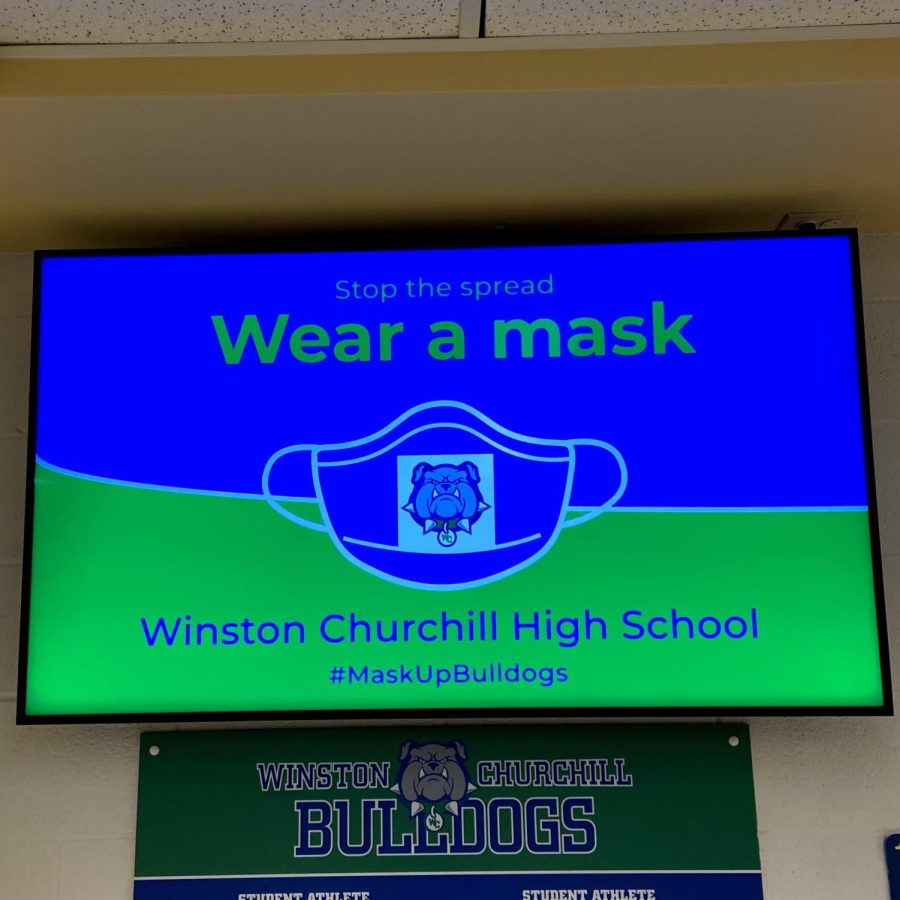Unknown effects of Omicron variant spreads uncertainty
A TV screen displays a “wear a mask” graphic in the hallway. WCHS already implements many health measures, but may create more if increased transmission occurs from the Omicron variant.
January 11, 2022
Nov. 24 was supposed to be a day of relaxation, one spent preparing for Thanksgiving and reuniting with family. But when the World Health Organization (WHO) reported the first case of COVID-19 variant B.1.1.529 (Omicron), a wave of fear swept over the world. Despite little circulation around the world, reports of increased transmissibility have prompted widespread panic over a new surge in the virus.
“It just feels like [the world is] back to where we were with the first case in California, way back in March of 2020,” WCHS nurse Ms. Simpson said. “I thought that we just did everything we could possibly do to keep this country safe… I thought that we were coming down to the [end of widespread transmission].”
Omicron was discovered under a month ago, so scientific data around the new variant is sparse. There is currently no hard evidence that the Omicron variant is any more transmissible than previous variants, but in South Africa (where the variant is already the dominant strain), there has been a sharp rise in cases, sparking fears over increased transmissibility.
“’I’m concerned that it’ll escalate and become a bigger thing in the United States. But I think for now, we should be fine,” WCHS senior Andrew Sidawy said.
Vaccines are currently the best weapon that the world has in the fight against COVID-19, and WCHS boasts a very high vaccination rate.
“[WCHS has a vaccination rate] between 94% and 98% of students. It’s just an added layer of protection. If you go to other areas of the country, it isn’t like this,” Simpson said.
The high vaccination rates are promising for WCHS’ prospect at remaining open in the case of a Omicron variant driven surge, but any unvaccinated student that catches COVID-19 is much more likely to spread the virus to students than a vaccinated one. This is why WCHS still emphasizes the importance of getting vaccinated.
“I [understand vaccine hesitancy,] because I was worried about vaccinating my children. But the thing that I always come back to is that I would really regret it if I could have done something and my children got sick. If I didn’t give that extra layer [of protection,] and something happened, I would never live with myself,” Simpson said.
Ever since vaccine efficacy seemed to be waning, calls for booster shots (a third shot for Pfizer and Moderna or a second shot for J&J) have intensified. On Nov. 19, the FDA approved booster shots for adults aged 18 and up. In addition, Pfizer has asked the government to authorize boosters for 16 and 17-year-olds. With boosters on the way for many WCHS students, the prospect of staying open full time through the end of the year is looking positive.
“Don’t let your guard down. I don’t want people to be scared [of Omicron.] I don’t want them to not live their lives… I just think that you should continue to wash your hands, wear masks when you’re indoors, but don’t live in fear,” said Simpson.
The future of Omicron might look murky for WCHS, but it is important to remember how much is not known about the variant. As of now, the best thing that WCHS students can do to protect their community is to get vaccinated. In the words of Sidawy, “Vaccines work, baby.”


